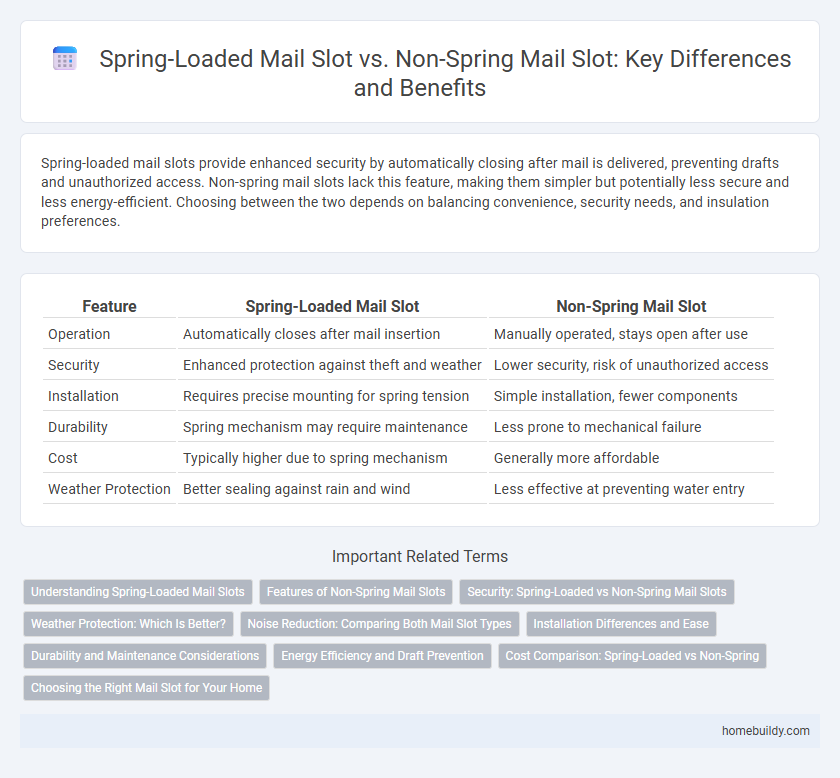Spring-loaded mail slots provide enhanced security by automatically closing after mail is delivered, preventing drafts and unauthorized access. Non-spring mail slots lack this feature, making them simpler but potentially less secure and less energy-efficient. Choosing between the two depends on balancing convenience, security needs, and insulation preferences.
Table of Comparison
| Feature | Spring-Loaded Mail Slot | Non-Spring Mail Slot |
|---|---|---|
| Operation | Automatically closes after mail insertion | Manually operated, stays open after use |
| Security | Enhanced protection against theft and weather | Lower security, risk of unauthorized access |
| Installation | Requires precise mounting for spring tension | Simple installation, fewer components |
| Durability | Spring mechanism may require maintenance | Less prone to mechanical failure |
| Cost | Typically higher due to spring mechanism | Generally more affordable |
| Weather Protection | Better sealing against rain and wind | Less effective at preventing water entry |
Understanding Spring-Loaded Mail Slots
Spring-loaded mail slots feature a built-in spring mechanism that automatically closes the slot after mail is inserted, enhancing security by preventing unauthorized access and reducing drafts. These mail slots provide better insulation compared to non-spring versions, which remain open and can allow cold air or pests to enter. The spring mechanism also helps protect the interior from weather elements and improves energy efficiency in both residential and commercial properties.
Features of Non-Spring Mail Slots
Non-spring mail slots offer a simple, durable design without mechanical components that can wear out or require maintenance, ensuring long-term reliability. These mail slots typically feature a fixed flap or cover that remains open or closed based on gravity or manual operation, reducing the risk of jamming or malfunction. Their straightforward construction makes them ideal for high-traffic areas where durability and minimal upkeep are crucial.
Security: Spring-Loaded vs Non-Spring Mail Slots
Spring-loaded mail slots enhance security by automatically closing after each use, preventing unauthorized access and reducing the risk of mail theft. Non-spring mail slots lack this self-closing feature, leaving gaps that could be exploited by intruders to reach inside or tamper with deliveries. Choosing a spring-loaded mail slot creates a more secure entry point by minimizing exposure and maintaining a sealed mailbox area.
Weather Protection: Which Is Better?
Spring-loaded mail slots provide superior weather protection by sealing tightly after each use, effectively preventing drafts, rain, and snow from entering the home. Non-spring mail slots often remain slightly open, allowing moisture and cold air to infiltrate, which can compromise indoor comfort and increase energy costs. Therefore, spring-loaded mail slots are the preferred choice for maintaining a weatherproof barrier in all seasons.
Noise Reduction: Comparing Both Mail Slot Types
Spring-loaded mail slots significantly reduce noise by cushioning the mail's impact against the slot flap, preventing loud banging sounds. Non-spring mail slots often produce more noise as mail directly strikes the door or interior, lacking a mechanism to absorb the impact. The presence of a spring mechanism is a key factor in minimizing noise disturbances and enhancing quiet mail delivery.
Installation Differences and Ease
Spring-loaded mail slots require precise alignment during installation to ensure the spring mechanism functions smoothly, often necessitating professional adjustment for optimal performance. Non-spring mail slots offer simpler installation with fewer moving parts, making them easier for DIY projects without the need for intricate calibration. The spring mechanism in spring-loaded slots also adds slight complexity in securing the slot to fit snugly against doors or walls, whereas non-spring slots typically have straightforward mounting requirements.
Durability and Maintenance Considerations
Spring-loaded mail slots offer enhanced durability by preventing external elements like rain, dust, and pests from entering, reducing wear and tear compared to non-spring designs. Maintenance is simpler with spring-loaded models as the self-closing mechanism limits buildup and damage, whereas non-spring mail slots require more frequent cleaning to avoid rust and debris accumulation. Selecting a spring-loaded mail slot ensures longer-lasting performance and less frequent upkeep for residential or commercial use.
Energy Efficiency and Draft Prevention
Spring-loaded mail slots significantly enhance energy efficiency by automatically sealing the slot after mail delivery, reducing air leakage and preventing heat loss. Non-spring mail slots often allow drafts that compromise indoor temperature control, leading to increased heating and cooling costs. Effective draft prevention from spring-loaded designs helps maintain consistent indoor climate and lowers energy consumption.
Cost Comparison: Spring-Loaded vs Non-Spring
Spring-loaded mail slots typically cost 20-40% more than non-spring mail slots due to their added mechanical components and enhanced durability. Non-spring mail slots offer a budget-friendly option with simpler installation and lower maintenance expenses. Evaluating the total cost of ownership, including potential repairs, helps determine which option provides better long-term value.
Choosing the Right Mail Slot for Your Home
Spring-loaded mail slots provide enhanced security and weather protection by automatically closing after mail is delivered, preventing drafts and unauthorized access. Non-spring mail slots offer a simpler design with easier installation and lower cost but may allow cold air and debris to enter. Choosing the right mail slot depends on balancing convenience, insulation needs, and security preferences for your home.
spring-loaded mail slot vs non-spring mail slot Infographic

 homebuildy.com
homebuildy.com